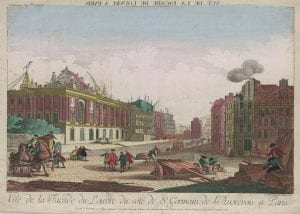Peep at a vue d’optique

The 18th century gave us the Enlightenment, the French Revolution and the lightning rod. It also gave us the less well known vue d’optique, a type of print that was viewed with a zograscope. These scenic prints were designed to be seen through an optical device comprising a lens and mirror which combined to form an experience commonly called a ‘peep show.’
Logically, perspective played an important role in these pre-photographic images because depth gave the picture the ability to advance and recede before the eyes of the viewer. They also offered the viewer the chance to travel by picture to far away destinations. Vue d’optique were exported around Europe and America, and notably, to Japan where they are credited with introducing Western perspective to Japanese printmakers.
Vue d’optique are identifiable by their use of extreme perspective, contrasting colours and by their titles which are printed in reverse.
Categories
- Uncategorised
- Japanese prints
- optics
- perspective
- Prints
- Vue d'optique
Leave a Reply